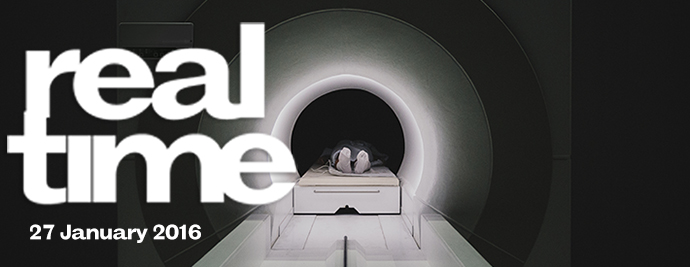The festival is anything but formulaic and this year the theme was percussion: anything that could be hit, struck and rock’n’rolled had its place in the jam-packed program. Several stages were spread across the grounds of the museum (inside and out) with performances taking place even inside the goods elevator. It was a true “Weekend at Walshy’s” with all the glitter, excitement and madness that festivalgoers have come to expect from this annual offering.
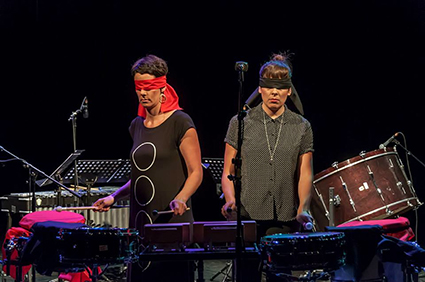 |
Claire Edwardes, Bree van Reyk, Ensemble Offspring photo courtesy the artists and Mofo 2016/MONA, Museum of Old and New Art, Hobart, Tasmania. |
Ensemble Offspring
Standing side-by-side, wearing white blindfolds, percussionists Claire Edwardes and Bree Van Reyk tackled the latter’s aptly titled Duet with Blindfold. The physicality of the performance was impressive as the duo launched effortlessly from woodblock to snare drum to tom drum, blindly navigating a plethora of instruments. Beneath Sidney Nolan’s epic Snake, Ensemble Offspring’s percussionists embarked on a program of absolute synchronicity. Ricocheting in the spacious gallery, the motoric woodblock claps of Steve Reich’s 1970 classic Music for Pieces of Wood became hypnotic as the established patterns shifted through their complex rhythmic discourse. Another of Van Reyk’s compositions, A Series of Breaths, provided a meditative reprieve, filling the air with ethereal vibraphone harmonics. Next, Edwardes tackled Xenakis’ Rebonds A/B, striking the drums with military precision and explosiveness. The gallery echoed with rapid gunfire, recalling the composer’s wartime experience. Concluding with Ligeti’s Continuum, Edwardes and Van Reyk controlled the vortex of perpetually propelled sound to wrap up a program that showcased these two powerhouse percussionists to perfection.
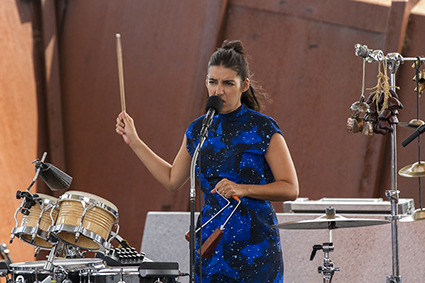 |
Wildbirds & Peacedrums (SWE) photo Rémi Chauvin, courtesy MONA |
Wildbirds & Peacedrums
Throbbing bass ebbs beneath a punching rock-ready drum beat. Vocal samples drift and drop, tambourine patterns emerge and disperse and a Björk-ish voice draws you in with pop magnetism. This vibrant mix of pop rock, electronic and jazz was the sound of Swedish duo Wildbirds & Peacedrums. At the core of the performance the elements were simple: vocals and percussion. Between them, drummer Andreas Werliin and vocalist Mariam Wallentin created a distinctively compelling sound using acoustic drums, oriental cymbals, drum machines and synth pads. Wallentin’s vocal prowess was evident as she shifted effortlessly between melodic throat singing and Patti Smith-style beat-song poetics, simultaneously controlling synth pads with her feet. The sultry vocals of “Gold Digger” overlaid wailing pre-recorded samples and Werliin’s polyrhythmic drum patterns, creating an expansive soundscape that seemed beyond the capabilities of just two performers.
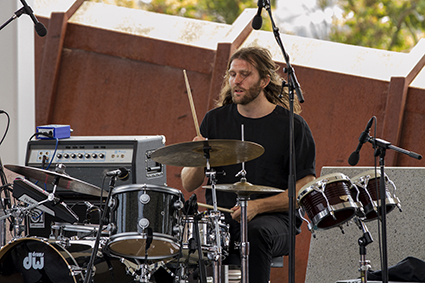 |
Wildbirds & Peacedrums (SWE) photo Rémi Chauvin, courtesy MONA |
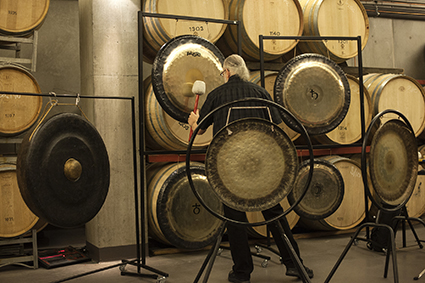 |
Michael Bettine photo MONA/Rémi Chauvin, image courtesy MONA, Museum of Old and New Art, Hobart, Tasmania |
Michael Bettine
Waves of metallic wash reverberate through Mona’s Barrel Room, a cold, dimly lit cement bunker lined with looming shelves of wooden barrels. It’s a non-traditional performance space that percussionist Michael Bettine filled with ebbing soundwaves from a small orchestra of gongs and bells. Explaining that we all vibrate with energy and that the gongs can affect our bodies on a deep, internal level with their resonating vibrations, he began slowly, stroking two gongs with felted mallets to produce a soft, airy tone. He then began to strike more frequently, moving between several gongs to create a wash of thrumming pulses. Expansive, metallic roars filled the air as Bettine used rubber-headed mallets to slowly ‘paint’ circles on the gongs. The striking of multiple gongs in succession created a rocking wave of harmonic dissonance. The sound was continuous in this mostly improvised performance, with no route or destination, no tension or release. The barrels were left behind as the room evolved into a space of meditative percussive textures, inviting the audience to listen, absorb and reflect without processing any pre-determined melodic structure. Bettine also used the mallets themselves as instruments, sometimes resting the end of a mallet on a gong face before striking the gong with another mallet, creating a buzzing rattle. The largest dark silver gong shuddered ominously when struck, emitting a series of thrumming pulses. Bettine played the room as much as the instruments, exploring the beating tones of vibrations that when combined sounded like a train rumbling underground. Creating a shifting wall of sound that washed over the audience, Bettine offered us a distinctive exploration into the craft of percussion.
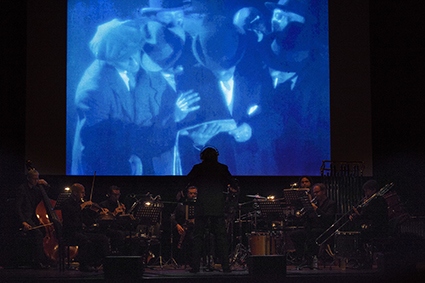 |
HERMESensemble, The Lodger photo Rémi Chauvin, courtesy MONA |
Music at one with visual art
Over the course of the festival, the music became one with the art as performers roamed throughout the museum, themselves three-dimensional creative expressions. Belgian-based HERMESensemble gave a new twist to the traditional museum tour, splitting into groups and wandering through the 14-metre underground Void issuing wailing clarinet phrases, haunting soprano siren calls and clattering flute motifs. Dancers appeared like dark shadows, the music flowing through their movements. The Tasmanian Symphony Orchestra Chorus sang of JS Bach’s blindness in the pitch darkness of the Barrel Room and then later appeared clad in white and navy bodysuits on the Escher-esque iron staircase. Finnish singer Mirel Wagner mesmerised audiences with her haunting ballads. “Hold your own”—the closing words from London-based rapper Kate Tempest—reminded festivalgoers to let go of societal expectations. Mofo 2016 did exactly that by taking 40,000 attendees on a freeform quest for sound, art and the unexpected.
Mofo 2016, Museum of Old and New Art [Mona] & various Hobart locations, Jan 13–18
Delia Bartle is a Hobart-based keyboardist and writer and the Australian Youth Orchestra’s 2015 Music Presentation Fellow.
© Delia Bartle; for permission to reproduce apply to [email protected]








 back
back